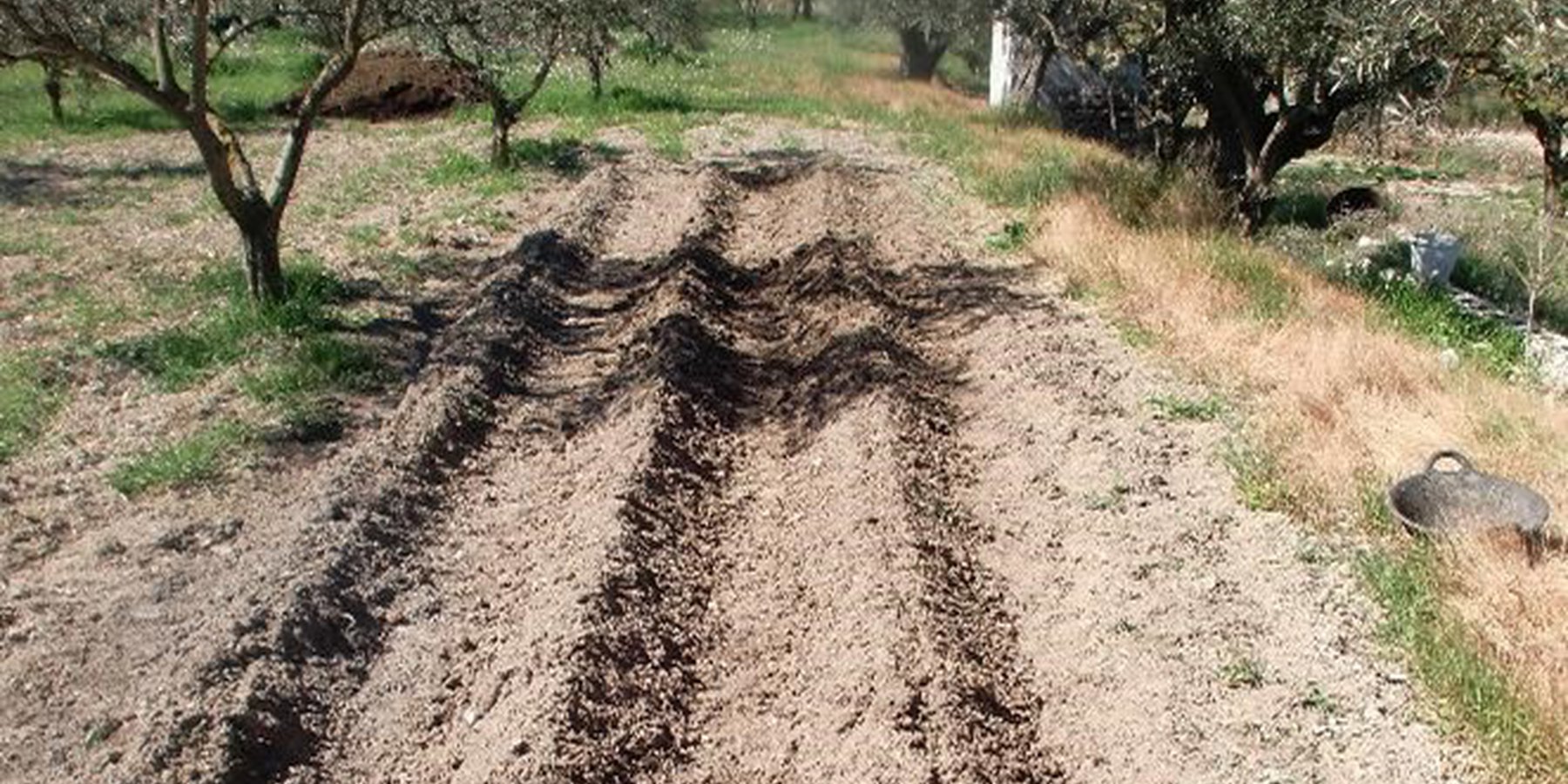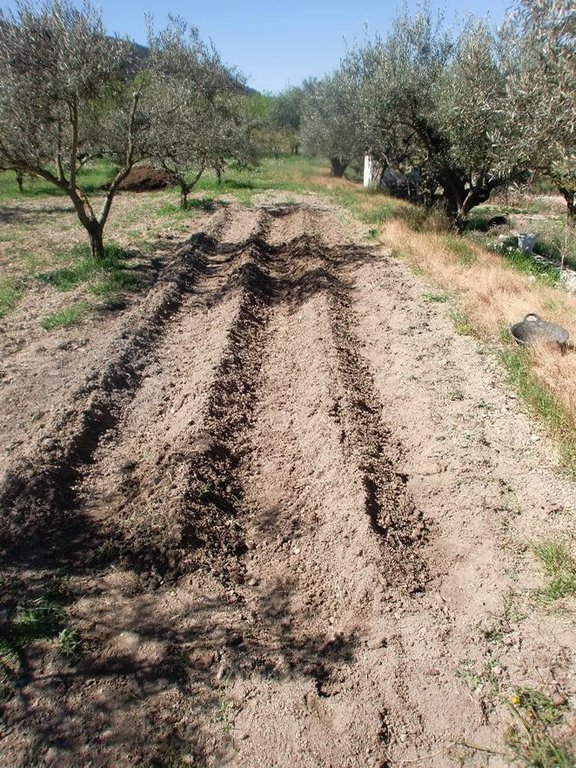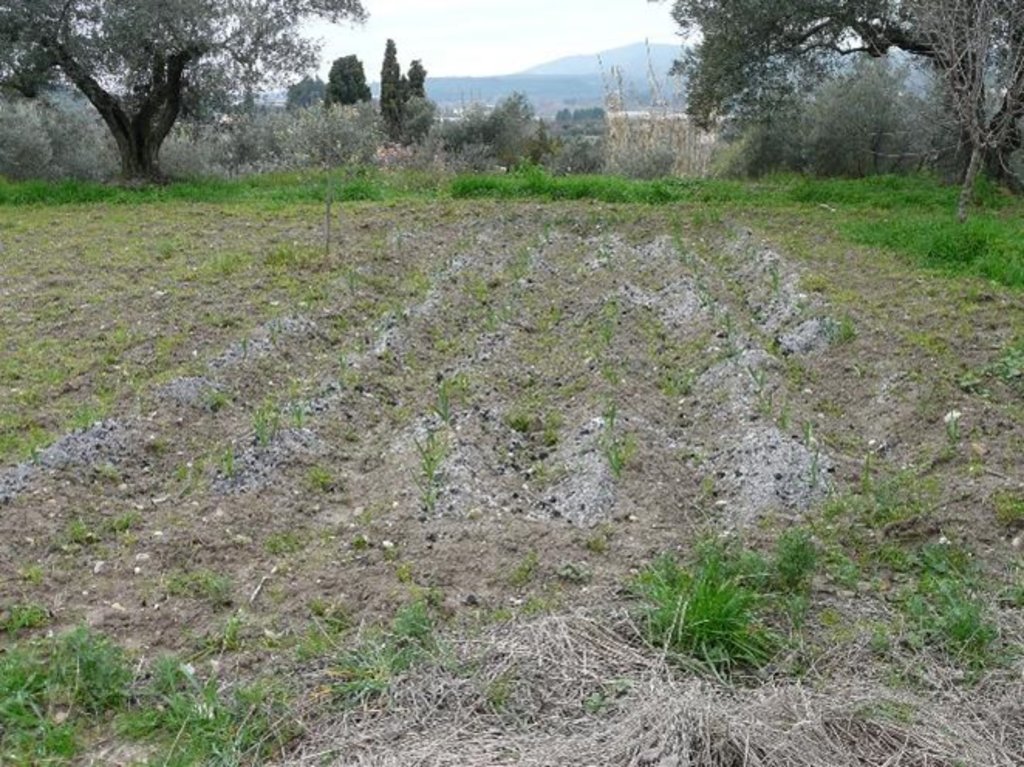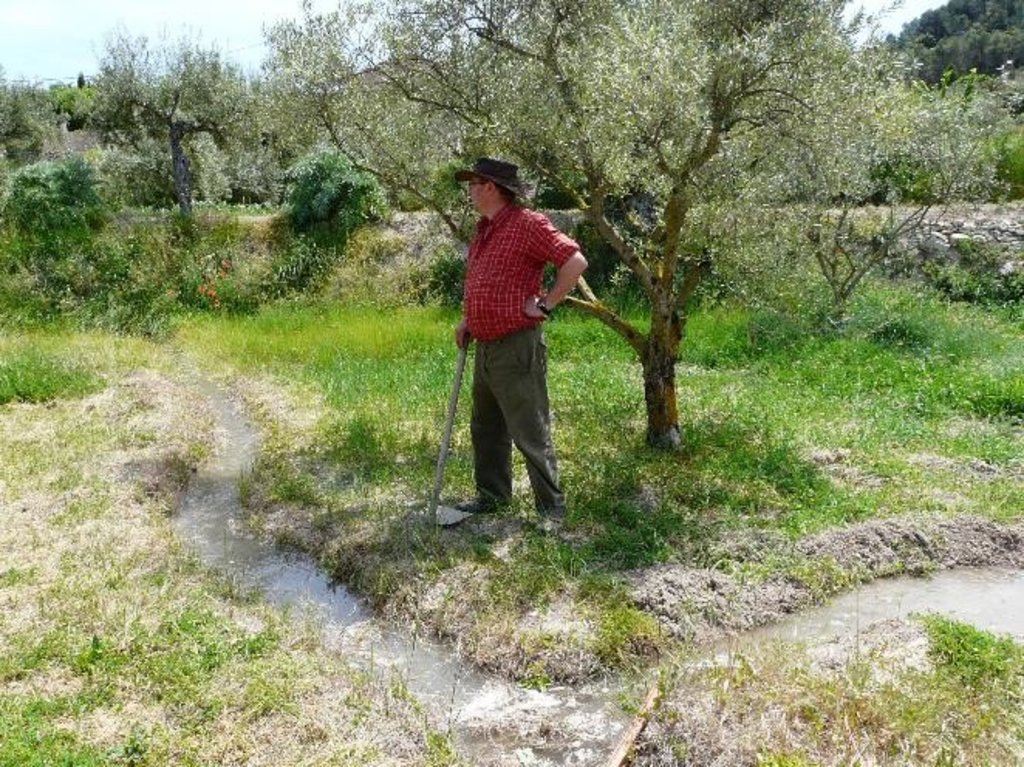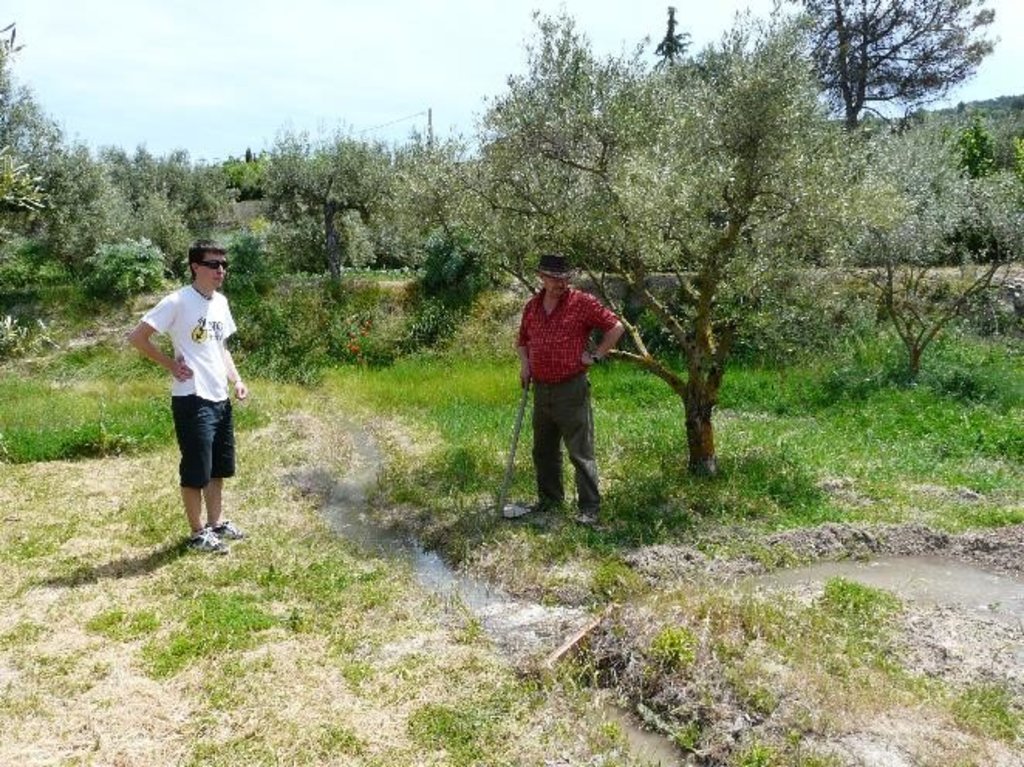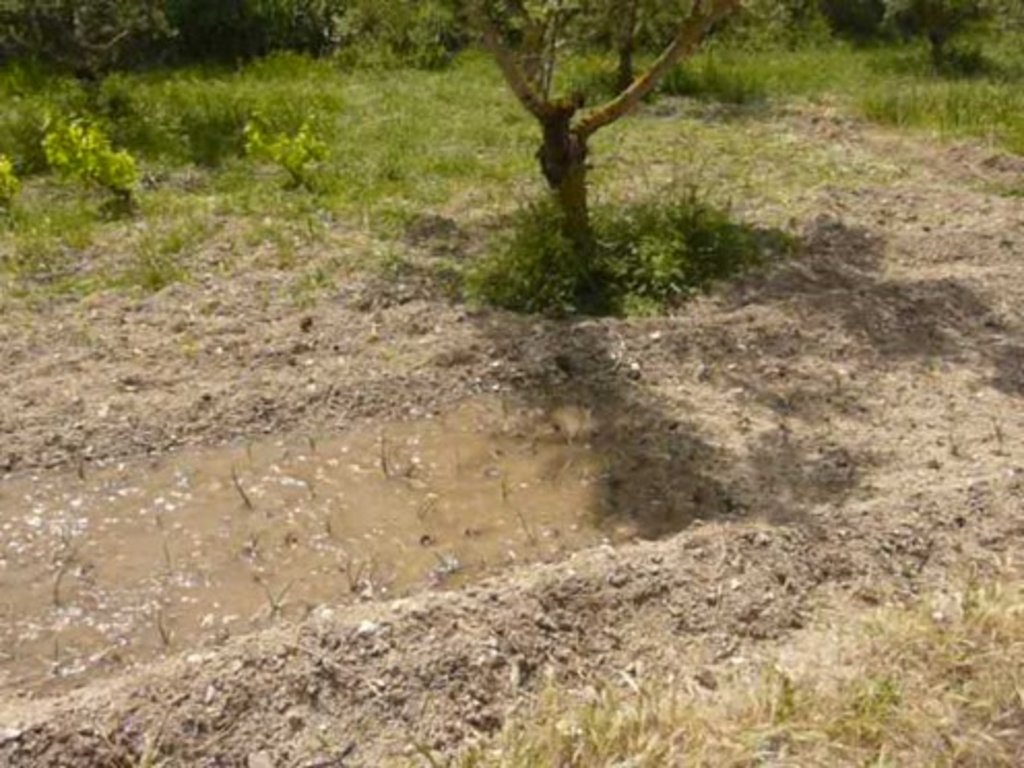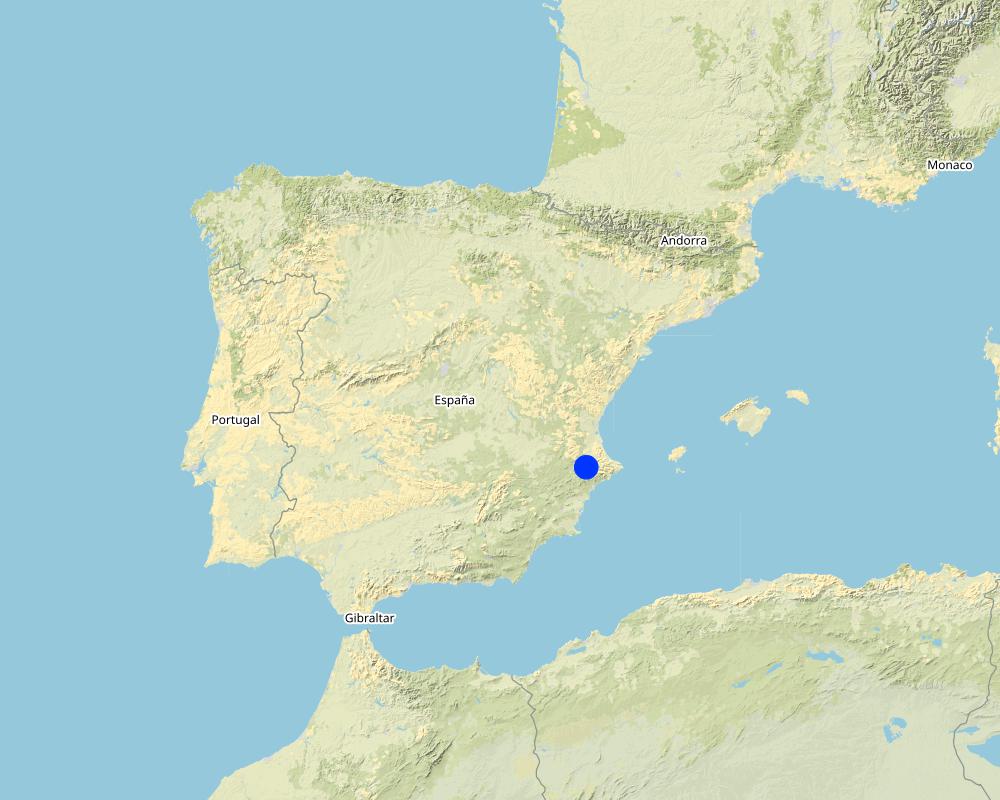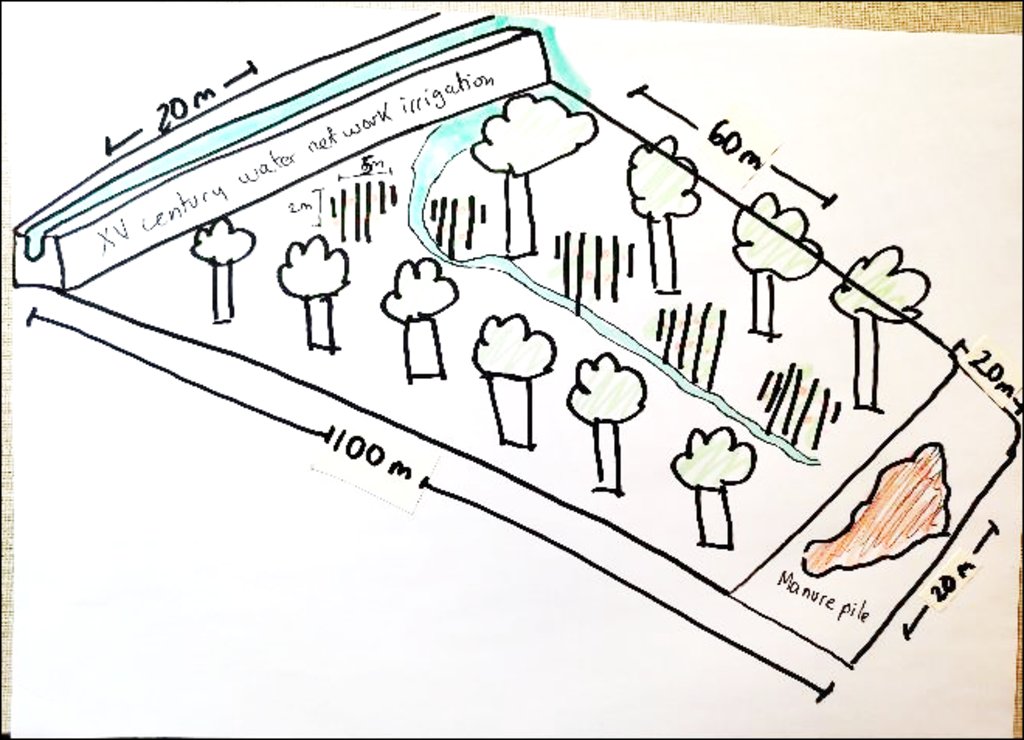Maintaining a 15th century irrigation system for a small orchard [ប្រទេសអេស្ប៉ាញ]
- ការបង្កើត៖
- បច្ចុប្បន្នភាព
- អ្នកចងក្រង៖ Alicia Morugán-Coronado
- អ្នកកែសម្រួល៖ –
- អ្នកត្រួតពិនិត្យច្រើនទៀត៖ William Critchley, Rima Mekdaschi Studer
Canalización de aguas de origen islámico en el riego de un huerto familiar
technologies_6435 - ប្រទេសអេស្ប៉ាញ
ពិនិត្យមើលគ្រប់ផ្នែក
ពង្រីកមើលទាំងអស់ បង្រួមទាំងអស់1. ព័ត៌មានទូទៅ
1.2 ព័ត៌មានលម្អិតពីបុគ្គលសំខាន់ៗ និងស្ថាប័នដែលចូលរួមក្នុងការវាយតម្លៃ និងចងក្រងឯកសារនៃបច្ចេកទេស
បុគ្គលសំខាន់ម្នាក់ (ច្រើននាក់)
អ្នកប្រើប្រាស់ដី:
Berenguer Bodí Mercedes
ប្រទេសអេស្ប៉ាញ
1.3 លក្ខខណ្ឌទាក់ទងទៅនឹងការប្រើប្រាស់ទិន្នន័យដែលបានចងក្រងតាមរយៈ វ៉ូខេត
អ្នកចងក្រង និង(បុគ្គលសំខាន់ៗ)យល់ព្រមទទួលយកនូវលក្ខខណ្ឌនានាទាក់ទងទៅនឹងការប្រើប្រាស់ទិន្នន័យដែលបានចងក្រងតាមរយៈវ៉ូខេត:
បាទ/ចា៎
1.4 សេចក្តីប្រកាសស្តីពីចីរភាពនៃការពណ៌នាពីបច្ចេកទេស
តើបច្ចេកទេសដែលបានពណ៌នានេះមានបញ្ហាដែលផ្តោតលើការធ្លាក់ចុះគុណភាពដី, បើដូច្នេះវាមិនអាចត្រូវបានប្រកាសថាជាបច្ចេកទេសនៃការគ្រប់គ្រងប្រកបដោយចីរភាពទេ?
ទេ
2. ការពណ៌នាពីបច្ចេកទេស SLM
2.1 ការពណ៌នាដោយសង្ខេបពីបច្ចេកទេស
និយមន័យបច្ចេកទេស:
A 15th century irrigation system is used on a small, intercropped and manured family orchard located in Valencia, in la Vall d’Albaida county (Spain)
2.2 ការពណ៌នាលម្អិតពីបច្ចេកទេស
ការពណ៌នា:
This technology is applied in a family orchard located in a small town (Bocairent) in Valencia, close to the Serra Mariola Natural Park. In the county of Vall d’Albaida, a 15th century system irrigates all the agricultural lands in the area. In this case study, the historical system has been used, since 1998, to irrigate a small plot of 0.2 ha. Water is diverted from the main water canal to a secondary channel which leads to the plot. Irrigation is applied when it is necessary, based on crop water requirements and the rainfall recorded. The original source of the water is the Serra Mariola range from where it flows into the Clarià river. Within the plot there are fruit trees as well as 5 subplots of 10 square meters (5 x 2m each). The subplots are used for vegetables (tomatoes, potatoes, fava beans, etc) under a rotational system (2 cycles per year). These 5 subplots are located between the rows of fruit trees (olives, almonds, figs, cherries, peaches), in an intercropping system. The whole field is fertilized annually with organic manure, which is stored at one end of the plot. This horse or sheep manure is acquired from a farm near the orchard. Pest control avoids artificial pesticides and fungicides: pests are controlled through encouraging natural predators. Weeds are removed by hand several times per season. The main purpose of this technology is the improvement of soil structure and organic matter content of the soil, while also preventing soil erosion caused by surface runoff. Avoiding pesticides and following an intercropping system gives multiple benefits: these include (a) maintaining biodiversity, (b) enhancing natural pollinators and pest predators, (c) respecting the Serra Mariola natural park, (d) improving ecosystem supporting services (nutrient cycling, soil formation, habitat provision, flood regulation) and regulating services (biological control pest and disease control), (d) creating pollination areas, and (e) encouraging carbon sequestration through permanent green cover in the intercropping system. Another benefit is the maintenance of cultural heritage: namely the 15th century, historically complex, irrigation system, which has been in use since being designed by Arabs up to the present day. Land users are continuously improving the technology by minimizing the impact on the agro-ecosystem through avoiding the use of pesticides. They are proud also with the improvement of the nutrient status of the soil, and the level of soil organic matter, achieved through the application of organic manure, as well as the intercropping and rotational system.
2.3 រូបភាពនៃបច្ចេកទេស
2.5 ប្រទេស/តំបន់/ទីតាំងកន្លែង ដែលបច្ចេកទេសត្រូវបានអនុវត្ត និងបានគ្រប់ដណ្តប់ដោយការវាយតម្លៃនេះ
ប្រទេស:
ប្រទេសអេស្ប៉ាញ
តំបន់/រដ្ឋ/ខេត្ត:
Valencia
បញ្ជាក់បន្ថែមពីលក្ខណៈនៃទីតាំង:
Bocairent
បញ្ជាក់ពីការសាយភាយនៃបច្ចេកទេស:
- អនុវត្តនៅកន្លែងជាក់លាក់មួយ/ ប្រមូលផ្តុំនៅតំបន់តូចៗ
តើបច្ចេកទេស (មួយ ឬច្រើន) ទាំងនោះស្ថិតនៅក្នុងតំបន់ការពារជាអចិន្ត្រៃយ៍ណាមួយដែរឬទេ?
ទេ
Map
×2.6 កាលបរិច្ឆេទនៃការអនុវត្ត
បង្ហាញឆ្នាំនៃការចុះអនុវត្ត:
1998
2.7 ការណែនាំពីបច្ចេកទេស
សូមបញ្ជាក់តើបច្ចេកទេសត្រូវបានណែនាំឱ្យអនុវត្តដោយរបៀបណា:
- តាមរយៈការបង្កើតថ្មីរបស់អ្នកប្រើប្រាស់ដី
- ជាផ្នែកនៃប្រព័ន្ធប្រពៃណី (> 50 ឆ្នាំ)
3. ចំណាត់ថ្នាក់នៃបច្ចេកទេស SLM
3.1 គោលបំណងចម្បង (១ ឬច្រើន) នៃបច្ចេកទេសនេះ
- ធ្វើឱ្យប្រសើរឡើងនូវផលិតកម្ម
- កាត់បន្ថយ, បង្ការ, ស្តារឡើងវិញនូវការធ្លាក់ចុះគុណភាពដី
- អភិរក្សប្រព័ន្ធអេកូឡូស៊ី
- ការពារតំបន់ទីជម្រាល/តំបន់ខ្សែទឹកខាងក្រោមបញ្ចូលជាមួយបច្ចេកទេសផ្សេងទៀត
- អភិរក្ស/ធ្វើឱ្យប្រសើរឡើងជីវចម្រុះ
3.2 ប្រភេទដីប្រើប្រាស់មួយប្រភេទ (ច្រើនប្រភេទ) ដែលបានអនុវត្តបច្ចេកទេស
ដីប្រើប្រាស់ចម្រុះនៅលើដីតែមួយ:
ទេ

ដីដាំដំណាំ
- ដំណាំប្រចាំឆ្នាំ
- ដំណាំរយៈពេលវែង (មិនមែនឈើ)
- ប្រភេទដើមឈើធំៗ និងដើមឈើតូចៗ
ចំនួនសារដែលដាំដំណាំក្នុងមួយឆ្នាំ:
- 2
សូមបញ្ជាក់:
Summer/Winter
តើជាការអនុវត្តន៍ដំណាំចន្លោះ?
បាទ/ចា៎

ផ្លូវទឹក ផ្ទៃទឹក ដីសើម
- ខ្សែទឹក ផ្លូវទឹក
3.3 បន្ទាប់ពីអនុវត្តបច្ចេកទេស តើដីប្រើប្រាស់មានការប្រែប្រួលដែររឺទេ?
បន្ទាប់ពីអនុវត្តបច្ចេកទេស តើដីប្រើប្រាស់មានការប្រែប្រួលដែររឺទេ?
- ទេ (បន្តទៅសំណួរ 3.4)
3.4 ការផ្គត់ផ្គង់ទឹក
ការផ្គត់ផ្គង់ទឹកនៅកន្លែងអនុវត្តបច្ចេកទេស:
- ទឹកភ្លៀង និងប្រព័ន្ធស្រោចស្រព
3.5 ក្រុម SLM ដែលបច្ចេកទេសស្ថិតនៅក្នុង
- ប្រព័ន្ធដំណាំបង្វិល (ការដាំដំណាំវិលជុំ ការទុកដីចោលដើម្បីបង្កើនជីជាតិ កសិកម្មពនេចរ)
- បញ្ចូលការគ្រប់គ្រងសត្វល្អិត និងជំងឺតាមបែបចម្រុះ (រួមទាំង កសិកម្មសរីរាង្គ)
- ការគ្រប់គ្រងប្រព័ន្ធស្រោចស្រព (រួមទាំងការផ្គត់ផ្គង់ទឹក ប្រព័ន្ធបង្ហូរ)
3.6 វិធានការ SLM ដែលបញ្ចូលនូវបច្ចេកទេស

វិធានការក្សេត្រសាស្ត្រ
- A1: ដំណាំ/គម្របដី
- A2: សារធាតុសរីរាង្គ/ជីជាតិដី
- A6: ការគ្រប់គ្រងកាកសំណល់

វិធានការរចនាស័ម្ពន្ធ
- S3: កម្ពស់ភ្លឺ ប្រឡាយ ផ្លូវទឹក
- S7: ការប្រមូលទឹកស្តុកទុក/ផ្គត់ផ្គង់ទឹក/ សម្ភារៈស្រោចស្រព
3.7 កំណត់ប្រភេទនៃការធ្លាក់ចុះគុណភាពដីសំខាន់ៗដែលបច្ចេកទេសនេះបានដោះស្រាយ

ការហូរច្រោះដីដោយសារទឹក
- Wt: ការបាត់ដីស្រទាប់លើដោយការហូរច្រោះ

ការធ្លាក់ចុះសារធាតុគីមីក្នុងដី
- Cn: ការថយចុះជីជាតិ និងកាត់បន្ថយបរិមាណសារធាតុសរីរាង្គ (មិនកើតឡើងដោយការហូរច្រោះទេ)

ការបាត់បង់ទឹក
- Hp: ការថយចុះគុណភាពទឹកនៅលើផ្ទៃដី
3.8 ការពារ កាត់បន្ថយ ឬស្តារឡើងវិញនៃការធ្លាក់ចុះគុណភាពដី
បញ្ជាក់ពីគោលដៅរបស់បច្ចេកទេស ដែលផ្តោតទៅការធ្លាក់ចុះគុណភាពដី:
- ការការពារការធ្លាក់ចុះគុណភាពដី
- ការកាត់បន្ថយការធ្លាក់ចុះគុណភាពដី
4. បច្ចេកទេសជាក់លាក់ សកម្មភាពអនុវត្ត ធាតុចូល និងថ្លៃដើម
4.1 គំនូសបច្ចេកទេសនៃបច្ចេកទេសនេះ
លក្ខណៈពិសេសនៃបច្ចេកទេស (ទាក់ទងនឺងគំនូរបច្ចេកទេស):
5 subplots of 10 square meters (5x2m) are used forvegetables crops (tomatoes, potatoes, fava beans, etc) in a crop rotation system (2 cycles per year). The subplots are between fruit trees line (olive tree, almond tree, fig tree, cherry tree, peaches trees), in an intercropping system. Irrigation is made with a temporal secondary channel from the mean water canal (51th century water network). All the agricultural field (0.2 ha) is fertilized annually with organic manure stored at the end of the plot.
ឈ្មោះអ្នកនិពន្ធ:
Alicia Morugan-Coronado
កាលបរិច្ឆេទ:
09/04/2022
4.2 ព័ត៌មានទូទៅដែលពាក់ព័ន្ធនឹងការគណនាធាតុចូល និងថ្លៃដើម
កំណត់របៀបនៃការគណនាថ្លៃដើម និងធាតុចូល:
- ក្នុងតំបន់អនុវត្តបច្ចេកទេស
កំណត់ទំហំ និងឯកត្តាផ្ទៃដី:
0.2 ha
ផ្សេងៗ/ រូបិយប័ណ្ណជាតិ (បញ្ជាក់):
euro
បើពាក់ព័ន្ធសូមកំណត់អត្រាប្តូរប្រាក់ពីដុល្លាទៅរូបិយប័ណ្ណតំបន់ (ឧ. 1 ដុល្លារ = 79.9 រៀលនៃរូបិយប័ណ្ណប្រេស៊ីល) ៖ 1 ដុល្លារ =:
0,99
4.3 សកម្មភាពបង្កើត
| សកម្មភាព | រយៈពេល (រដូវកាល) | |
|---|---|---|
| 1. | Soil preparation | One per season |
| 2. | Soil ploughing | Twice per year (2 cycles rotation) |
| 3. | Manuring | Once per year |
| 4. | Water irrigation | Periodically |
| 5. | Tree plantation | Once per year |
| 6. | Vegetables plantation | Twice per year (2 cycles rotation) |
4.4 ថ្លៃដើម និងធាតុចូលដែលត្រូវការសម្រាប់ការបង្កើតបច្ចេកទេស
| បញ្ជាក់ពីធាតុចូល | ឯកតា | បរិមាណ | ថ្លៃដើមក្នុងមួយឯកតា | ថ្លៃធាតុចូលសរុប | % នៃថ្លៃដើមដែលចំណាយដោយអ្នកប្រើប្រាស់ដី | |
|---|---|---|---|---|---|---|
| កម្លាំងពលកម្ម | Manuring | person-day | 1,0 | 100,0 | ||
| កម្លាំងពលកម្ម | Soil ploughing or soil preparation | person-day | 4,0 | 10,0 | 40,0 | 100,0 |
| កម្លាំងពលកម្ម | Water irrigation | litres | 100,0 | 100,0 | ||
| កម្លាំងពលកម្ម | Plants plantation | person-day | 2,0 | 25,0 | 50,0 | 100,0 |
| សម្ភារៈ | Hoe | piece | 1,0 | 10,0 | 10,0 | 100,0 |
| សម្ភារៈ | shovel | piece | 1,0 | 18,0 | 18,0 | 100,0 |
| សម្ភារៈដាំដុះ | Seed | gr | 200,0 | 1,0 | 200,0 | 100,0 |
| សម្ភារៈដាំដុះ | Tree | piece | 25,0 | 15,0 | 375,0 | 100,0 |
| សម្ភារៈដាំដុះ | Vegetables | piece | 25,0 | 4,0 | 100,0 | 100,0 |
| ជី និងសារធាតុពុល | Horse or sheep manure | kg | 80,0 | 100,0 | ||
| ថ្លៃដើមសរុបក្នុងការបង្កើតបច្ចេកទេស | 793,0 | |||||
| ថ្លៃដើមសរុបក្នុងការបង្កើតបច្ចេកទេសគិតជាដុល្លារ | 801,01 | |||||
4.5 សកម្មភាពថែទាំ
| សកម្មភាព | ពេលវេលា/ ភាពញឹកញាប់ | |
|---|---|---|
| 1. | Weeding | 4 times per year |
| 2. | Harvesting | 2 times per year |
| 3. | Manuring | 1 time per year |
| 4. | Vegetables or seed plantation | 2 times per year o vegetable cycle |
| 5. | Tree re-plantation | Eventually if tree loss |
| 6. | Soil ploughing | 2 times per year or vegetables cycle |
| 7. | Water irrigation | Periodically |
4.6 កំណត់ថ្លៃដើមសម្រាប់ការថែទាំ/ សកម្មភាពរបស់បច្ចេកទេស (ក្នុងរយៈពេលមួយឆ្នាំ)
| បញ្ជាក់ពីធាតុចូល | ឯកតា | បរិមាណ | ថ្លៃដើមក្នុងមួយឯកតា | ថ្លៃធាតុចូលសរុប | % នៃថ្លៃដើមដែលចំណាយដោយអ្នកប្រើប្រាស់ដី | |
|---|---|---|---|---|---|---|
| កម្លាំងពលកម្ម | Weeding | person-day | 1,0 | 100,0 | ||
| កម្លាំងពលកម្ម | Harvesting | person-day | 1,0 | 100,0 | ||
| កម្លាំងពលកម្ម | Soil ploughing | person-day | 1,0 | 100,0 | ||
| កម្លាំងពលកម្ម | Water irrigation | Litres | 100,0 | 100,0 | ||
| សម្ភារៈ | Hoe | piece | 1,0 | 10,0 | 10,0 | 100,0 |
| សម្ភារៈ | Scissors | piece | 1,0 | 10,0 | 10,0 | 100,0 |
| សម្ភារៈ | Shovel | piece | 1,0 | 15,0 | 15,0 | 100,0 |
| សម្ភារៈដាំដុះ | Seed | gr | 200,0 | 1,0 | 200,0 | 100,0 |
| សម្ភារៈដាំដុះ | Vegetables plant | pieces | 20,0 | 4,0 | 80,0 | 100,0 |
| សម្ភារៈដាំដុះ | Fruit trees plant | pieces | 5,0 | 18,0 | 90,0 | 100,0 |
| ជី និងសារធាតុពុល | Manuring | Kg | 80,0 | 100,0 | ||
| ផ្សេងៗ | Weeding | person-day | 1,0 | 100,0 | ||
| ថ្លៃដើមសរុបសម្រាប់ការថែទាំដំណាំតាមបច្ចេកទេស | 405,0 | |||||
| ថ្លៃដើមសរុបសម្រាប់ការថែទាំដំណាំតាមបច្ចេកទេសគិតជាដុល្លារ | 409,09 | |||||
4.7 កត្តាសំខាន់បំផុតដែលមានឥទ្ធិពលដល់ការចំណាយ
ពណ៌នាពីកត្តាប៉ះពាល់ចម្បងៗទៅលើថ្លៃដើម:
The users has already the material and the plants, only the manure is a gift from a neighbour
5. លក្ខណៈបរិស្ថានធម្មជាតិ និងមនុស្ស
5.1 អាកាសធាតុ
បរិមាណទឹកភ្លៀងប្រចាំឆ្នាំ
- < 250 មម
- 251-500 មម
- 501-750 មម
- 751-1,000 មម
- 1,001-1,500 មម
- 1,501-2,000 មម
- 2,001-3,000 មម
- 3,001-4,000 មម
- > 4,000 មម
កំណត់បរិមាណទឹកភ្លៀង (បើដឹង) ជា មីលីម៉ែត្រ:
520,00
លក្ខណៈពិសេស/ មតិយោបល់លើរដូវភ្លៀង:
Bocairent has dry periods in January, February, March, June, July, August and December.
On average, September is the wettest month with 2 inch (50 mm) of precipitation.
On average, July is the driest month with 0.2 inch (4 mm) of precipitation.
តំបន់កសិអាកាសធាតុ
- មានភ្លៀងតិចតួច
In Bocairent, the average annual temperature is 15.5 °C | 60.0 °F.
5.2 សណ្ឋានដី
ជម្រាលជាមធ្យម:
- រាបស្មើ (0-2%)
- ជម្រាលតិចតួច (3-5%)
- មធ្យម (6-10%)
- ជម្រាលខ្ពស់បន្តិច (11-15%)
- ទីទួល (16-30%)
- ទីទួលចោត (31-60%)
- ទីទួលចោតខ្លាំង (>60%)
ទម្រង់ដី:
- ខ្ពង់រាប
- កំពូលភ្នំ
- ជម្រាលភ្នំ
- ជម្រាលទួល
- ជម្រាលជើងភ្នំ
- បាតជ្រលងភ្នំ
តំបន់តាមរយៈកម្ពស់ :
- 0-100 ម
- 101-500 ម
- 501-1,000 ម
- 1,001-1,500 ម
- 1,501-2,000 ម
- 2,001-2,500 ម
- 2,501-3,000 ម
- 3,001-4,000 ម
- > 4,000 ម
បញ្ជាក់ថាតើបច្ចេកទេសនេះត្រូវបានអនុវត្តន៍នៅក្នុង:
- មិនពាក់ព័ន្ធទាំងអស់
មតិយោបល់ និងបញ្ចាក់បន្ថែមអំពីសណ្ឋានដី :
Is a flat terrain, approximately 1% slope.
5.3 ដី
ជម្រៅដីជាមធ្យម:
- រាក់ខ្លាំង (0-20 សម)
- រាក់ (21-50 សម)
- មធ្យម (51-80 សម)
- ជ្រៅ (81-120 សម)
- ជ្រៅខ្លាំង (> 120 សម)
វាយនភាពដី (ស្រទាប់លើ):
- មធ្យម (ល្បាយ, ល្បាប់)
វាយនភាពដី (> 20 សម ស្រទាប់ក្នុង):
- ម៉ត់/ ធ្ងន់ (ឥដ្ឋ)
សារធាតុសរីរាង្គនៅស្រទាប់ដីខាងលើ:
- ទាប (<1%)
5.4 ទឹកដែលអាចទាញមកប្រើប្រាស់បាន និងគុណភាពទឹក
នីវ៉ូទឹកក្រោមដី:
< 5 ម
ទឹកលើដីដែលអាចទាញយកប្រើប្រាស់បាន:
ល្អ
គុណភាពទឹក (មិនបានធ្វើប្រត្តិកម្ម):
ទឹកពិសារដែលមានគុណភាពល្អ
គុណភាពទឹក គឺផ្តោតទៅលើ៖:
ទឹកលើផ្ទៃដី
តើមានបញ្ហាភាពទឹកប្រៃហូរចូលមកដែរឬទេ?
ទេ
តើទឹកជំនន់កំពុងកើតមាននៅតំបន់នេះដែររឺទេ?
បាទ/ចា៎
ភាពទៀងទាត់:
ម្តងម្កាល
5.5 ជីវៈចម្រុះ
ភាពសម្បូរបែបនៃប្រភេទ:
- ខ្ពស់
ភាពសម្បូរបែបនៃទីជម្រក:
- ខ្ពស់
5.6 លក្ខណៈនៃអ្នកប្រើប្រាស់ដីដែលអនុវត្តបច្ចេកទេស
នៅមួយកន្លែង ឬពនេចរ :
- នៅមួយកន្លែង
ទីផ្សារនៃប្រព័ន្ធផលិតកម្ម:
- សម្រាប់ហូបក្នុងគ្រួសារ (ផ្គត់ផ្គង់ខ្លួនឯង)
ចំណូលក្រៅកសិកម្ម:
- ច្រើនជាង 50% នៃចំណូល
កម្រិតជីវភាព:
- មធ្យម
ឯកជន ឬក្រុម:
- ធ្វើខ្លួនឯង/ គ្រួសារ
កម្រិតប្រើប្រាស់គ្រឿងយន្ត:
- ប្រើកម្លាំងពលកម្ម
យេនឌ័រ:
- ស្ត្រី
អាយុរបស់អ្នកប្រើប្រាស់ដី:
- វ័យកណ្តាល
សូមបញ្ជាក់ពីលក្ខណៈពាក់ព័ន្ធផ្សេងទៀតអំពីអ្នកប្រើប្រាស់ដី:
It is a family with 6 members of different ages, the oldest is 60 years-old and the youngest 24 years old
5.7 ទំហំផ្ទៃដីជាមធ្យមនៃដីប្រើប្រាស់ដោយអ្នកប្រើប្រាស់ដី ក្នុងការអនុវត្តបច្ចេកទេស
- < 0.5 ហិកតា
- 0.5-1 ហិកតា
- 1-2 ហិកតា
- 2-5 ហិកតា
- 5-15 ហិកតា
- 15-50 ហិកតា
- 50-100 ហិកតា
- 100-500 ហិកតា
- 500-1,000 ហិកតា
- 1,000-10,000 ហិកតា
- > 10,000 ហិកតា
តើផ្ទៃដីនេះចាត់ទុកជាទំហំកម្រិតណាដែរ ខ្នាតតូច មធ្យម ឬខ្នាតធំ (ធៀបនឹងបរិបទតំបន់)?
- ខ្នាតតូច
មតិយោបល់:
0.2 ha
5.8 ភាពជាម្ចាស់ដី កម្មសិទ្ធប្រើប្រាស់ដី និងកម្មសិទ្ធប្រើប្រាស់ទឹក
ភាពជាម្ចាស់ដី:
- ឯកជន មានកម្មសិទ្ធ
កម្មសិទ្ធិប្រើប្រាស់ដី:
- ឯកជន
កម្មសិទ្ធប្រើប្រាស់ទឹក:
- ឯកជន
តើកម្មសិទ្ធប្រើប្រាស់ដី គឺផ្អែកលើប្រព័ន្ធច្បាប់បែបបុរាណ?
បាទ/ចា៎
5.9 ការប្រើប្រាស់សេវាកម្ម និងហេដ្ឋារចនាសម្ព័ន្ធ
សុខភាព:
- មិនល្អ
- មធ្យម
- ល្អ
ការអប់រំ:
- មិនល្អ
- មធ្យម
- ល្អ
ជំនួយបច្ចេកទេស:
- មិនល្អ
- មធ្យម
- ល្អ
ការងារ (ឧ. ការងារក្រៅកសិដ្ឋាន):
- មិនល្អ
- មធ្យម
- ល្អ
ទីផ្សារ:
- មិនល្អ
- មធ្យម
- ល្អ
ថាមពល:
- មិនល្អ
- មធ្យម
- ល្អ
ផ្លូវ និងការដឹកជញ្ជូន:
- មិនល្អ
- មធ្យម
- ល្អ
ទឹកផឹក និងអនាម័យ:
- មិនល្អ
- មធ្យម
- ល្អ
សេវាកម្មហិរញ្ញវត្ថុ:
- មិនល្អ
- មធ្យម
- ល្អ
6. ផលប៉ះពាល់ និងការសន្និដ្ឋាន
6.1 ផលប៉ះពាល់ក្នុងបរិវេណអនុវត្តបច្ចេកទេសដែលកើតមាន
ផលប៉ះពាល់លើសេដ្ឋកិច្ចសង្គម
ផលិតផល
ផលិតកម្មដំណាំ
មតិយោបល់/ ការបញ្ជាក់:
The user observes an increase in yield year per year, even in the fruit trees
គុណភាពដំណាំ
មតិយោបល់/ ការបញ្ជាក់:
The user says that the quality of the vegetables increases annually (visual observation)
ទឹកដែលអាចទាញមកប្រើប្រាស់បាន និងគុណភាពទឹក
ទឹកបរិភោគដែលអាចទាញយកមកប្រើប្រាស់បាន
មតិយោបល់/ ការបញ្ជាក់:
The user explain that avoiding the use of pesticides and inorganic fertilization, the quality of water is better than before
ចំណូល និងថ្លៃដើម
ការចំណាយលើធាតុចូលកសិកម្ម
មតិយោបល់/ ការបញ្ជាក់:
Because the manure is a gift, no costs are involve in fertilization labour. Avoiding pesticides is another reason to decrease the agricultural inputs
ផលប៉ះពាល់ទៅលើវប្បធម៌សង្គម
សន្តិសុខស្បៀង/ ភាពគ្រប់គ្រាន់ខ្លួនឯង
មតិយោបល់/ ការបញ្ជាក់:
The user and its family self-consumed the vegetables that they harvest in the orchard
ស្ថានភាពសុខភាព
មតិយោបល់/ ការបញ្ជាក់:
Avoiding pesticides and chemical fertilization the health risks decreased on the user and its family
ឱកាសនៃការបង្កើតថ្មី
មតិយោបល់/ ការបញ្ជាក់:
The legacy of the orchard to the next family members is assured because is a tradition to spend weekends working on the orchard and later eat Paella (a traditional Spanish dish)
ចំណេះដឹង SLM / ការធ្លាក់ចុះគុណភាពដី
មតិយោបល់/ ការបញ្ជាក់:
The user learns about soil quality and degratation with the experience and observation
ផលប៉ះពាល់ទៅលើអេកូឡូស៊ី
វដ្តទឹក/លំហូរ
លំហូរទឹកលើផ្ទៃដី
មតិយោបល់/ ការបញ្ជាក់:
the permanent green cover as an intercropping system maintains the soil and decreases surface runoff
ដី
សំណើមដី
មតិយោបល់/ ការបញ្ជាក់:
the permanent green cover as an intercropping system maintains the soil moisture
គម្របដី
មតិយោបល់/ ការបញ្ជាក់:
the permanent green cover as an intercropping system maintains the soil
ការបាត់បង់ដី
មតិយោបល់/ ការបញ្ជាក់:
the permanent green cover as an intercropping system avoids soil loss
ការកើនឡើងដី
មតិយោបល់/ ការបញ្ជាក់:
the permanent green cover as an intercropping system enhances soil formation
ដីប្រេះ
មតិយោបល់/ ការបញ្ជាក់:
the permanent green cover as an intercropping system decreases soil sealing
ដីហាប់
មតិយោបល់/ ការបញ្ជាក់:
the permanent green cover and the manure application decreases soil compactation
វដ្តនៃសារធាតុចិញ្ចឹម/ការទទួលបាន
មតិយោបល់/ ការបញ្ជាក់:
the permanent green cover and the manure application increases nutrient cycling
សារធាតុសរីរាង្គដី/ការបូនក្រោមដី
មតិយោបល់/ ការបញ្ជាក់:
the permanent green cover and the manure application increases organic matter anually
ជីវចម្រុះ៖ ដំណាំ, សត្វ
ដំណាំគម្រប
មតិយោបល់/ ការបញ្ជាក់:
The intercropping system maintain vegetation cover during the year between fruit trees rows
ជីវម៉ាស/ កាបូនលើដី
មតិយោបល់/ ការបញ្ជាក់:
The intercropping system maintain biomassC during the year between fruit trees rows
ភាពសម្បូរបែបនៃរុក្ខជាតិ
មតិយោបល់/ ការបញ្ជាក់:
The intercropping system increases plant diversity during the year between fruit trees rows
ប្រភេទរាតត្បាត
មតិយោបល់/ ការបញ្ជាក់:
The intercropping system attracts pollinators and pest predators naturally
ភាពសម្បូរបែបនៃសត្វ
មតិយោបល់/ ការបញ្ជាក់:
The intercropping system enhances the presence of birds or little mammals
ការគ្រប់គ្រងកត្តាចង្រៃ/ ជំងឺ
មតិយោបល់/ ការបញ្ជាក់:
The intercropping system enhances the pest control with the presence of natural killers pest
6.2 ផលប៉ះពាល់ក្រៅបរិវេណអនុវត្តបច្ចេកទេសដែលកើតមាន
លំហូរទឹកដែលអាចប្រើប្រាស់បាននៅរដូវប្រាំង
Buffering/សមត្ថភាពចម្រោះ
6.3 ភាពប្រឈម និងភាពរួសនៃបច្ចេកទេសទៅនឹងការប្រែប្រួលអាកាសធាតុ និងគ្រោះអាកាសធាតុ/ គ្រោះមហន្តរាយ (ដែលដឹងដោយអ្នកប្រើប្រាស់ដី)
ការប្រែប្រួលអាកាសធាតុ
ការប្រែប្រួលអាកាសធាតុ
| រដូវកាល | កើនឡើង ឬថយចុះ | លក្ខណៈឆ្លើយតបនៃបច្ចេកទេសទៅនឹងការប្រែប្រួលអាកាសធាតុ | |
|---|---|---|---|
| សីតុណ្ហភាពប្រចាំឆ្នាំ | កើនឡើង | មធ្យម | |
| សីតុណ្ហភាពប្រចាំរដូវកាល | រដូវស្លឹកឈើជ្រុះ | កើនឡើង | មធ្យម |
| បរិមាណទឹកភ្លៀងប្រចាំឆ្នាំ | កើនឡើង | ល្អ | |
| បរិមាណទឹកភ្លៀងប្រចាំរដូវកាល | រដូវស្លឹកឈើជ្រុះ | កើនឡើង | ល្អ |
គ្រោះអាកាសធាតុ (មហន្តរាយ)
គ្រោះមហន្តរាយធម្មជាតិ
| លក្ខណៈឆ្លើយតបនៃបច្ចេកទេសទៅនឹងការប្រែប្រួលអាកាសធាតុ | |
|---|---|
| ព្យុះទឹកកកតាមតំបន់ | ល្អ |
| ព្យុះខ្សាច់តាមតំបន់ | ល្អ |
គ្រោះមហន្តរាយអាកាសធាតុ
| លក្ខណៈឆ្លើយតបនៃបច្ចេកទេសទៅនឹងការប្រែប្រួលអាកាសធាតុ | |
|---|---|
| រលកកម្តៅ | ល្អ |
| រលកត្រជាក់ | ល្អណាស់ |
| រាំងស្ងួត | ល្អ |
| ភ្លើងឆេះព្រៃ | ល្អណាស់ |
គ្រោះមហន្តរាយទឹក
| លក្ខណៈឆ្លើយតបនៃបច្ចេកទេសទៅនឹងការប្រែប្រួលអាកាសធាតុ | |
|---|---|
| ទឹកជំនន់ដោយទឹកភ្លៀង | ល្អ |
គ្រោះមហន្តរាយជីវៈសាស្ត្រ
| លក្ខណៈឆ្លើយតបនៃបច្ចេកទេសទៅនឹងការប្រែប្រួលអាកាសធាតុ | |
|---|---|
| ការមានបញ្ហាសត្វល្អិត/ដង្កូវ | ល្អ |
6.4 ការវិភាគថ្លៃដើម និងអត្ថប្រយោជន៍
តើផលចំណេញ និងថ្លៃដើមត្រូវបានប្រៀបធៀបគ្នាយ៉ាងដូចម្តេច (ទស្សនៈរបស់អ្នកប្រើប្រាស់ដី)?
រយៈពេលខ្លី:
វិជ្ជមានតិចតួច
រយៈពេលវែង:
វិជ្ជមានខ្លាំង
តើផលចំណេញ និងការថែទាំ/ ជួសជុលត្រូវបានប្រៀបធៀបគ្នាយ៉ាងដូចម្តេច (ទស្សនៈរបស់អ្នកប្រើប្រាស់ដី)?
រយៈពេលខ្លី:
ប៉ះពាល់តិចតួចបំផុត
រយៈពេលវែង:
ប៉ះពាល់តិចតួចបំផុត
6.5 ការទទួលយកបច្ចេកទេស
- តែមួយករណី /ពិសោធន៍
ក្នុងចំណោមគ្រួសារទាំងអស់ដែលបានអនុវត្តបច្ចេកទេស តើមានប៉ុន្មានគ្រួសារដែលចង់ធ្វើដោយខ្លួនឯង ដោយមិនទទួលបានសម្ភារៈលើកទឹកចិត្ត/ប្រាក់ឧបត្ថម្ភ?:
- 0-10%
6.6 ការបន្សុំា
តើថ្មីៗនេះ បច្ចេកទេសនេះត្រូវបានកែតម្រូវដើម្បីបន្ស៊ាំទៅនឹងស្ថានភាពប្រែប្រួលដែរឬទេ?
ទេ
6.7 ភាពខ្លាំង/ គុណសម្បត្តិ/ ឱកាសនៃបច្ចេកទេស
| ភាពខ្លាំង/ គុណសម្បត្តិ/ ឱកាសនៅកន្លែងរបស់អ្នកប្រើប្រាស់ដី |
|---|
| Free pesticides orchard, with organic manure from local farm and maintaining irrigation water supply following millenary water rules |
| Eating healthily |
| Saving money in vegetables and fruit orchards |
| Eating your own grow food |
| ភាពខ្លាំង/ គុណសម្បត្តិ/ ឱកាស ទស្សនៈរបស់បុគ្គលសំខាន់ៗ |
|---|
| Improvement in soil structure and minimizing soil compactation |
| Improvement in organic matter content |
| Controlling water erosion on surface |
| Maintaining biodiversity of natural reserve avoiding the use of pesticides |
6.8 ភាពខ្សោយ/ គុណវិបត្តិ/ ហានិភ័យនៃបច្ចេកទេស និងវិធីសាស្ត្រដោះស្រាយ
| ភាពខ្សោយ/ គុណវិបត្តិ/ ហានិភ័យ ទស្សនៈរបស់អ្នកប្រើប្រាស់ដី | តើបច្ចេកទេសទាំងនោះបានដោះស្រាយបញ្ហាដូចម្តេច? |
|---|---|
| Manual hours for land preparation | Family help on weekends |
| Pest control manual | Try new methods or assessing the correct moment to do the control |
| Controlling spontaneus plants manually | Diversify orchard to minimize the presence of spontaneous plants |
| ភាពខ្សោយ/ គុណវិបត្តិ/ ហានិភ័យ ទស្សនៈរបស់អ្នកចងក្រងឬបុគ្គលសំខាន់ៗ | តើបច្ចេកទេសទាំងនោះបានដោះស្រាយបញ្ហាដូចម្តេច? |
|---|---|
| Initial preparation of terrain | Overcome by saving cost in annual crop yield |
| Improving knowledgement in crop diversification | Receiving technical advice from experts |
| Problems in pest control | Improving the presence of beneficial insects or predators |
7. ឯកសារយោង និងវេបសាយ
7.1 វិធីសាស្ត្រ/ ប្រភពនៃព័ត៌មាន
- តាមការចុះទីវាល ការស្រាវជ្រាវនៅទីវាល
1 field visit
- ការសម្ភាសន៍ជាមួយអ្នកប្រើប្រាស់ដី
10 land user interviews
- ការចងក្រងពីរបាកការណ៍ និងឯកសារផ្សេងៗទៀតដែលមាន
តើពេលណាដែលទិន្នន័យបានចងក្រង (នៅទីវាល)?
09/04/2022
មតិយោបល់:
One in situ interview (09 April 2022) and the rest of info was compiled by phone with the land user
7.2 ឯកសារយោងដែលបានចេញផ្សាយ
ចំណងជើង អ្នកនិពន្ធ ឆ្នាំ ISBN:
Historical irrigation system at l'Horta de València
មានប្រភពមកពីណា? ថ្លៃដើមប៉ុន្មាន?
https://www.fao.org/giahs/news/newsletter-detail/es/c/1253069
ចំណងជើង អ្នកនិពន្ធ ឆ្នាំ ISBN:
Los regadíos tradicionales del Vinalopó (Alto y Medio). Jorge Hermosilla, ed. Colección: Regadíos Históricos Valencianos. ISBN: 978-84-370-6777-3
មានប្រភពមកពីណា? ថ្លៃដើមប៉ុន្មាន?
https://puv.uv.es/los-regadios-tradicionales-del-vinalopo-alto-y-medio.html?___store=espanyol&___from_store=valencia
ចំណងជើង អ្នកនិពន្ធ ឆ្នាំ ISBN:
Los regadíos tradicionales del Vinalopó (Alto y Medio) AUTOR/A: HERMOSILLA PLA, JORGE
មានប្រភពមកពីណា? ថ្លៃដើមប៉ុន្មាន?
https://www.todostuslibros.com/libros/los-regadios-tradicionales-del-vinalopo-alto-y-medio_978-84-482-4686-0
ចំណងជើង អ្នកនិពន្ធ ឆ្នាំ ISBN:
Los regadíos históricos españoles paisajes cuturales, paisajes sostenibles AUTOR/A: HERMOSILLA PLA, JORGE / PEÑA ORTIZ, MARTÍN / ANTEQUERA FERNÁNDEZ, MIGUEL 978-84-491-1000-9
មានប្រភពមកពីណា? ថ្លៃដើមប៉ុន្មាន?
https://www.todostuslibros.com/libros/los-regadios-historicos-espanoles_978-84-491-1000-9
ចំណងជើង អ្នកនិពន្ធ ឆ្នាំ ISBN:
Evaluación patrimonial de azudes en la demarcación hidrográfica del Júcar AUTOR/A: HERMOSILLA PLA, JORGE 978-84-17508-17-3 / Tirant Humanidades
មានប្រភពមកពីណា? ថ្លៃដើមប៉ុន្មាន?
https://www.todostuslibros.com/libros/evaluacion-patrimonial-de-azudes-en-la-demarcacion-hidrografica-del-jucar_978-84-17508-17-3
ចំណងជើង អ្នកនិពន្ធ ឆ្នាំ ISBN:
Cuadernos de historia de España versión impresa ISSN 0325-1195versión On-line ISSN 1850-2717 Cuad. hist. Esp. v.80 Buenos Aires ene./dic. 2006
មានប្រភពមកពីណា? ថ្លៃដើមប៉ុន្មាន?
http://www.scielo.org.ar/scielo.php?script=sci_arttext&pid=S0325-11952006000100002
7.3 ការភ្ជាប់ទៅកាន់ព័ត៌មានពាក់ព័ន្ធលើប្រព័ន្ធអនឡាញ
ចំណងជើង/ ពណ៌នា:
Heritage-catalogue valencian
វេបសាយ:
https://www.uv.es/horta-valencia-chair/en/heritage-catalogue/presentacio-del-cataleg/presentacio.html
ចំណងជើង/ ពណ៌នា:
ESTEPA RESEARCH GROUP
វេបសាយ:
https://www.uv.es/uvweb/departamento-geografia/es/investigacion/grupos-investigacion/estepa-estudios-del-territorio-del-patrimonio-/actividades-del-grupo/lineas-investigacion-1285858445772.html
ចំណងជើង/ ពណ៌នា:
Bocairent guided visits
វេបសាយ:
https://www.visitabocairent.com/bocairent-y-el-agua/
ការតភ្ជាប់ និងម៉ូឌុល
ពង្រីកមើលទាំងអស់ បង្រួមទាំងអស់ការតភ្ជាប់
គ្មានការតភ្ជាប់
ម៉ូឌុល
គ្មានម៉ូឌុល


